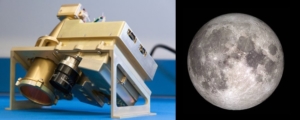Brimrose is proud to announce that Brimrose Technology Corporation has been selected to be a part of future missions to the Moon. Brimrose’s signature Acoustic Optic technology will assist NASA in helping researchers understand what form the Moon’s hydrogen takes and its behavior in the lunar environment.
NASA is looking to use spectrometers to detect different types of minerals and ices present. Those including frozen carbon dioxide, ammonia, and methane, to differentiate between water and hydroxyl.
Brimrose is working on a new spectrometer that was designed specifically for this mission as a part of NASA’s Lunar Payload Development Program, a subdivision of the Commercial Lunar Payload Services (CLPS) initiative, and the Near Infrared Volatiles Spectrometer System (NIRVSS). NIRVSS is a complementary suite of detectors that target the measurement of lunar volatiles. It is intended to visit a permanently shadowed region at one of the lunar poles. The instrument spans the 1300-4000 nm range that allows for the identification of H2O bands.
“It will be thrilling to start receiving data generated by our spectrometer from the Moon’s surface,” said Vladimir Stanislavsky, Chief Operating Officer at Brimrose. “Our core NIR AOTF technology has been used on Earth by major pharmaceutical companies, the food industry for analysis, and for many other applications, but this is the first time it will be used on the Moon to find water.”
Dr. Feng Jin from Brimrose’s technical team is working primarily with the NASA Ames Research Center team in California’s Silicon Valley to verify that the ruggedized design matches well to NASA’s specifications. Prototypes for the custom spectrometer have been built and participated in thermal-vacuum drill testing at NASA’s Glenn Research Center in Cleveland, OH. Where the instrument operated in lunar-like conditions and monitored drill cuttings from H2O-doped lunar simulant for water ice.
There is no set date as to when the next mission is looking to launch.


